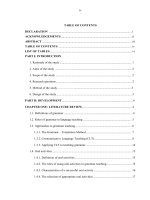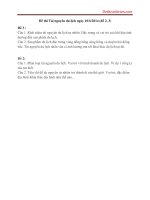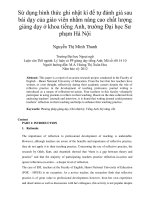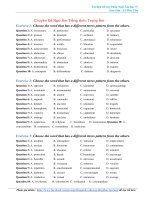TIẾNG ANH 3 ĐẠI HỌC THƯƠNG MẠI Tips to shop online
Bạn đang xem bản rút gọn của tài liệu. Xem và tải ngay bản đầy đủ của tài liệu tại đây (71.61 KB, 13 trang )
VIETNAM UNIVERSITY OF COMMERCE
FACULTY OF ENGLISH
GROUP DISCUSSION
ENGLISH 2
Topic
: Tips to shop online
Group
:8
Class
: 1672ENTH1511
Teacher
:
Group preparation assessment:
Presentation assessment: List of students (in the order of presenting )
No.
Name ( for students )
Comments ( for teacher only )
Mark
1
2
3
4
5
6
7
PRESENTATION OUTLINE
1
I. INTRODUCTION
1. Greeting:
Good afternoon, everyone! We are group 8. Today we are very happy to be here to talk about tips
to shop online.
2. Introducing the group’s members:
There are seven members in our group: Duc Vuong, Hai Yen, Binh Dat, Mai Anh, My Duyen,
Ngoc Anh and me, my name is Ha.
3. Introducing the group’s topic:
There are eight parts in our presentation. The first is introduction. The second is shopping at
secure websites. The third part is about researching the website before you order. The fourth is
reading the website's privacy and security policies. The fifth is What's safest: credit card, debit
cards, cash or checks. The sixth is disclosing only the bar facts when you order. The seventh part
mentions keeping your password private and check the website address. And the final part is
about the awareness of Dynamic pricing.
II. Development:
1. Introduction ( the first part is being presented by Vuong Thi Ngoc Anh)
As you know that, shopping online is a big business these days with more and more
consumers turning to the world wide web to purchase goods. There are a lot of reasons for
this: you can compare prices between each shop, pick up bargains, have various selection…
We can’t deny the advantages of shopping online, however, something can go wrong as in
the real world. Sometimes, it is simply a case of computer glitch or poor customer service.
Other times, shoppers are cheated by the bad guys who lay in wait or the thieves attempt to
swindle you out of your sign in credentials and even credit card. While somewhat alarming,
these states should not keep you from shopping online, you just need some common sense
and practical advice. We have put 7 top tips on how to stay safe and secure when shopping
online.
•
•
•
•
Shopping at secure websites
Researching the website before you order
Reading the website's privacy and security policies
What's safest : credit card, debit cards, cash or checks
2
• Disclosing only the bar facts when you order
• Keeping your password private and check the website address
• Being aware of Dynamic pricing
2. Shopping at secure websites ( The second part is being presented by Vuong Thi Ngoc
Anh)
How can you tell if a website is secure? Secure websites use encryption technology to
transfer information from your computer to the online merchant's computer. Encryption
scrambles the information you send such as your credit card number, in order to prevent
computer hackers from obtaining it while in transit. The only people who can unscramble the
code are those with legitimate access privileges. Here's how you can tell when you are
dealing with a secure site:
• If you look at the top of your screen where the website address is displayed, you
should see https://. The "s" that is displayed after "http" indicates that website is
secure. Often, you do not see the "s" until you actually move to the order page on the
website.
• Another way to determine if a website is secure is to look for a closed padlock
displayed on the address bar of your screen. If that lock is open, you should assume it
is not a secure site.
3. Researching the website before you order (the third part is being presented by
Nguyen Thi My Duyen)
• Sticking to the famous store, or try to find reviews by consumers independently of
their experience; also ensure that there is comprehensive contact information on the
website before using the service, and note if the retailer has enrolled in the
monitoring program as an industry trust mark or a trust mark.
• Before buying from a new company, evaluate the website by considering issues such
as: the professionalism and friendliness of the site; whether or not the company lists
a telephone number and / or street address along with the electronic information and
communication; whether a completely fair, reasonable and return policy is clearly
defined; and whether there is hidden price inflators, such as transport costs and
excessive handling.
• Ensuring that retailers can accept the privacy policy posted. For example, note if the
retailer does not explicitly state that it will not share personal information with others
without consent.
3
• Make sure that the vendor addresses are protected by SSL (see above) when entering
credit card information. If the address on the screen enter your credit card
information begins with "HTTPS".
• Use strong passwords that do not contain personal information such as the user's
name or birth date. Another option is a "pass phrase," that would be something along
the lines of: "I have a buyer shopping 4 !!" These are difficult to hack, since they do
not include words found in the dictionary, and offers a wide range of characters on,
lower, and special. The password can be site specific and can be easy to remember.
4. Reading the website’s privacy and security policies (the fourth part is being
presented by Nguyen Thi Mai Anh)
Each online website typically has parts for your providing information and how data
processing is. It’s usually on the list of privacy policies. If merchants sell your information
for other people even any linking company, you can find them. On the other hand, if the
company has your information, they can let other companies restrict their marketing to
customers. Or else, it is possible for you to receive spam messages or worthless events, even
companies’s solicitation calls.
You can also find out what the type of information collected by the web is and how it is not
shared with others. The online data baseoftraders are secured in the privacy policy or security
policy in particular.
However strict the privacy policy is, it’s not sure whether the merchants keep your
information a secret permanently. That policy can be changed when the company goes
bankrupt and then sells customers’ data for other one.
Therefore, there are still many gaps in your security information when you do shopping
online.
5. What’s safest: credit card, debit cards, cash or checks (the fifth part is being
presented by Vu Hai Yen)
Nowadays, shopping online is more and more popular. Shopping online has many advantages
but it has many disadvantages too. One of the problems is payment. Customer should use
credit card or debit card, check or cash to pay the bill ? Which is handier and safer?
Credit and debit cards typically look almost identical, but they are different.
4
Debit card:
• Debit card allow bank customers to spend money that they have by drawing on funds
that they deposited with the card provide.
• Fees: Frugal consumers prefer to use debit cards because they usually have few or no
fees of any kind, unless users spend more than they have in their account and incur
an overdraft fee.
• Controlling spending: A debit card draws on money the user already has. Compulsive
spenders would do well do use debit cards and avoid the temptation of credit
• DEBIT CARD FRAUD
According to the Electronic Funds Transfer Act (the primary of debit card), your
potential liability for fraudulent debit card transactions is virtually unlimited. You
have up to 60 days to report a lost or stolen card under the EFTA. After that, you
simply lose whatever money was taken, even funds siphoned from linked accounts.
The exact liability limits under the EFTA are:
Lost or stolen card reported before unauthorized transactions: zero liability.
Lost or stolen card reported within two days: $50 liability limit.
Lost or stolen card reported within 60 days: $500 liability limit.
After 60 days: no protection.
It’s important to note that if your card is not physically lost or stolen, you have 60
days to report fraudulent transactions with zero liability. If only your card number is
stolen, the 60 days start from the date of the statement on which a fraudulent
transaction appears.
Credit card
• Credit card allow consumers to borrow money from the card issuer up to a certain
limit in order to purchase items or withdraw cash.
• Fees: credit cards generally charge annual fees, over-limit fees, late-payment fees
and a plethora of other fees and penalties, in addition to monthly interest on the
card's outstanding balance.
• CREDIT CARD FRAUD: Under the Fair Credit Billing Act (the primary law of
credit card), your maximum liability for fraudulent credit card transactions is $50. If
you report your card lost or stolen before any fraudulent transactions occur, your
liability is zero.
The real difference between a debit card and a credit card when it comes to fraud is in how
you get your money back. When a fraudulent transaction occurs on your credit card, you
have lost no money. You can report the fraud, get a credit on your statement, and the issue
will never affect your bank account. With a debit card, your bank account balance is affected
from the moment the fraudulent transaction takes place. If the transactions are significant,
5
you could experience a domino effect of financial headaches. Fraudulent charges can tie up
funds so that legitimate charges are declined or cause overdrafts.
Cash
Keeping cash on hand can be a great way to avoid overspending. You can choose exactly
how much cash you're willing to spend, carry it with you, and stop spending when you're out
of cash. But you shouldn’t online shopping by cash because you could be transferring cash
to a fraudster. Scammers will ask consumers to send them payment using a money transfer
service such as Western Union or Money Gram because they can get your cash fast and it’s
difficult to trace. Legitimate sellers normally do not ask consumers to send payment that
way. Money transfer services should only be used to send money to people that you know
well, not to unknown sellers of merchandise online
Check
Online shopping by personal check leaves you vulnerable to bank fraud. Sending a cashier's
check or money order doesn't give you any protection if you have problems with the
purchase.
So that, online shopping by credit card is the best choice.
6. Disclosing only the bar facts when you order (The sixth part is being presented by
Hoang Duc Vuong)
When placing an order, there is certain information that you must provide to the web
merchant such as your name and address. Often, a merchant will try to obtain more
information about you. They may ask questions about your leisure lifestyle or annual income.
This information is used to target you for marketing purposes. It can lead to spam or direct
mail and telephone solicitation.
Don't answer any question you feel is not required to process your order. Often, the website
will mark which questions need to be answered with an asterisk (*). Should a company
require information you are not comfortable sharing, find a different company that sells the
product.
6
Providing your Social Security number is not a requirement for placing an order at an online
shopping site. There is no need for the merchant to ask for it. Giving out your Social Security
number could lead to having your identity stolen.
7.
Keeping your password private and check the website address (the seventh part is
being presented by Ngo Binh Dat)
When you order something, there is certain information that you must to provide to the
website such as your name, your address, your phone number , etc. Often, a company or shop
will try to take more information about you. This information is used to target you for
marketing purposes. They will send to your email, your mobile phone, or your address to
invite you for buying their products.
Don't answer any question you feel is not necessary to process your order. Often, the website
will mark which questions need to be answered with an asterisk (*). If a company require
information that you are not comfortable, you should find a different company that sells the
product.
Providing important information is extremely dangerous. It lead to having your identity
stolen.
8. Being aware of Dynamic pricing ( the eighth part is being presented by Nguyen Thi
Ha)
Some online retailers use dynamic pricing to engage in price discrimination by charging
different prices to different consumers for identical goods or services. When you purchase
goods or services online, you may be paying a higher or lower price than another online
customer buying the same item from the same site at the same time. While online shopping
enables consumers to easily compare prices, it also allows businesses to collect detailed
information about a customer's purchasing history and preferences. Online stores can use that
information to customize the price they charge you.
For items of the sensitive nature of time as airline tickets, hotel reservations, car rental, ... the
online sales can freely use to rise up prices for commodities and this is for those who lost
their purchase online.
7
Online merchants can easily implement dynamic pricing by placing cookies on a customer's
computer which will track the user's past interactions with the site. By using this information,
sites can customize their interactions based on your past activities. Online stores can read the
cookies on your browser to determine what products or services you searched for and bought
and how much you paid for them. This information helps them to predict how much you
might be willing to pay for a product or service.
Some online stores may also consider other factors when determining pricing. For example,
merchants might charge higher prices to customers who make repeated returns or demand
extra service.
There are several ways that you may be able to defeat dynamic pricing. Obviously, do not log
in to a site before you obtain a price quote. Be sure to clear the cookies from your browser
before you visit a site. Utilize price comparison sites that check prices from multiple
vendors. Finally, if you do log in to a site, try leaving items in your shopping cart for a few
days, to see if the merchant offers any discounts.
8
MEETING MINUTES – GROUP: 8
I. Time
: From 8:00 to 10:00
II. Place
: yard of school library
III. Members : 1. Vuong Thi Ngoc Anh
2. Nguyen Thi My Duyen
3. Nguyen Thi Mai Anh
4. Vu Hai Yen
5. Hoang Duc Vuong
6. Ngo Binh Dat
7. Nguyen Thi Ha
IV. Contents for discussing:
1. The members introduce and familiarize
2. The exploitation: Shopping at secure websites
Research the website before you order
Read the website's privacy and security policies
What's safest : credid card , debit cards , cash or checks
Disclose only the bar facts when you order
Keep your password private and check the website address
Be aware of Dynamic pricing
3. Reference: Head for business (Jon Naunton 2002)
Webpages
V. Conclusion: Tips to shop online
VI. Duties for members:members collect more information in one week
Head of the team
( Signature and name )
Secretary
( Signature and name )
9
MEETING MINUTES – GROUP: 8
I. Time
: From 8:00 to 10:00
II. Place
: yard of school library
III. Members : 1. Vuong Thi Ngoc Anh
2. Nguyen Thi My Duyen
3. Nguyen Thi Mai Anh
4. Vu Hai Yen
5. Hoang Duc Vuong
6. Ngo Binh Dat
7. Nguyen Thi Ha
IV. Contents for discussing:
1. Aggregated information and pick out pieces of information needed for discussion
2. Removing irrelevant information
3. Determine the contents of the discussion
4. Add content missing
V. Conclusion: members prepared for their task in 1 week
VI. Duties for members:
Head of the team
( Signature and name )
Secretary
( Signature and name )
MEETING MINUTES – GROUP: 8
I. Time
: From 8:00 to 10:00
II. Place
: yard of school library
III. Members : 1. Vuong Thi Ngoc Anh
10
2. Nguyen Thi My Duyen
3. Nguyen Thi Mai Anh
4. Vu Hai Yen
5. Hoang Duc Vuong
6. Ngo Binh Dat
7. Nguyen Thi Ha
IV. Contents for discussing:
1. Synthesize information into a sequence of content want to present
2. Photocopy this pamphlet to members of the group so that members are aware of all of the
group discussions
3.Assigned to each member of each part in preparing brochures
V.Conclusion: members prepared for their task in 1 week
VI. Duties for members:
1. Vuong Thi Ngoc Anh: Introduction
2.
3.
4.
5.
6.
7.
Shopping at secure websites
Nguyen Thi My Duyen: Researching the website before you order
Nguyen Thi Mai Anh: read the website's privacy and security policies
Vu Hai Yen: What's safest : credid card , debit cards , cash or checks
Hoang Duc Vuong: Disclosing only the bar facts when you order
Ngo Binh Dat: Keeping your password private and check the website address
Nguyen Thi Ha: Being aware of Dynamic pricing
Head of the team
( Signature and name )
Secretary
( Signature and name )
MEETING MINUTES – GROUP: 8
I. Time
: From 8:00 to 10:00
II. Place
: yard of school library
III. Members : 1. Vuong Thi Ngoc Anh
2. Nguyen Thi My Duyen
3. Nguyen Thi Mai Anh
11
4. Vu Hai Yen
5. Hoang Duc Vuong
6. Ngo Binh Dat
7. Nguyen Thi Ha
IV. Contents for discussing:
1. Synthesize information into a sequence of content want to present
2. Photocopy this pamphlet to members of the group so that members are aware of all of the
group discussions
3.Assigned to each member of each part in preparing brochures
4. Practice the presentation
V.Conclusion:members prepared for their task in 1 week
VI. Duties for members: Learn by heart and practice the pronouciation
Head of the team
( Signature and name )
Secretary
( Signature and name )
12
13









